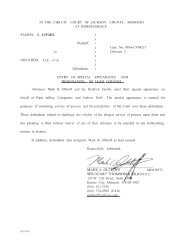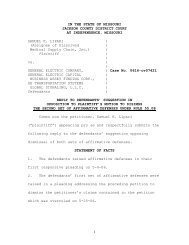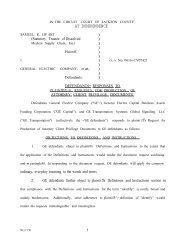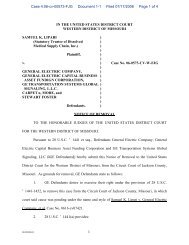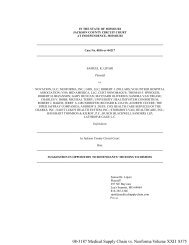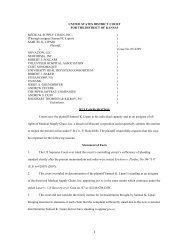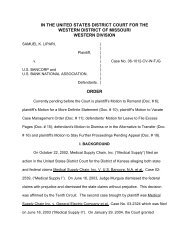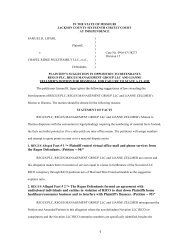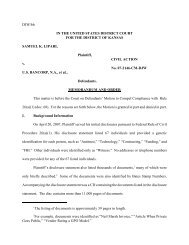Seyfarth Shaw Motion to Dismiss - Medical Supply Chain
Seyfarth Shaw Motion to Dismiss - Medical Supply Chain
Seyfarth Shaw Motion to Dismiss - Medical Supply Chain
Create successful ePaper yourself
Turn your PDF publications into a flip-book with our unique Google optimized e-Paper software.
IN THE UNITED STATES DISTRICT COURTWESTERN DISTRICT OF MISSOURISAMUEL K. LIPARI,Plaintiff,vs.GENERAL ELECTRIC COMPANY, et aI.,Defendants.)))))))))Case No. 07-0849-CV-W-FJGMOTION OF SEPARATE DEFENDANTSEYFARTH SHAW LLP TO DISMISSCOMES NOW the separate defendant, <strong>Seyfarth</strong> <strong>Shaw</strong> LLP, and pursuant <strong>to</strong> Rule 12(b)(6),Federal Rules of Civil Procedure, moves the Court <strong>to</strong> dismiss the Complaint filed herein against thisdefendant, on the following bases:1. The Complaint fails <strong>to</strong> state a claim on which relief may be granted against thisseparate defendant;2. Plaintiff lacks standing <strong>to</strong> bring a RICO claim;3. The defendant law firm owed no legal duty <strong>to</strong> the plaintiff;4. The Complaint is barred by collateral es<strong>to</strong>ppel and claim preclusion;5. The Complaint violates Rule 8, Federal Rules of Civil Procedure.I. BACKGROUND.1. This action was originally filed on March 22, 2006 in the Circuit Court of JacksonCounty, Missouri as Case No. 0616-CV07421.In his initial Complaint, plaintiff named defendantsGeneral Electric; General Electric Capital Business Asset Funding Corporation; GE TransportationSystems; Global Signaling LLC; Carpets N More; and Heartland Financial.or 1235851
2. This action was subsequently removed by the defendants <strong>to</strong> this Court on November9,2007, after plaintiff was granted leave <strong>to</strong> file an amended Petition on Oc<strong>to</strong>ber 31,2007.3. In his Complaint, the plaintiff claims <strong>to</strong> be the "assignee" of the claims of <strong>Medical</strong><strong>Supply</strong> <strong>Chain</strong>, Inc.Complaint, ~16. The only claims sought <strong>to</strong> be asserted against this separatedefendant are based solely on the Racketeer Influenced and Corrupt Organizations Act ("RICO"). 1The only section of that statute relied upon is 18 U.S.C. §1962(d). Complaint, ~146.4. The facts of plaintiffs claims against defendant <strong>Seyfarth</strong> <strong>Shaw</strong> LLP are listed in thefollowing paragraphs of the Complaint:~131: "<strong>Seyfarth</strong> <strong>Shaw</strong> LLP ... direct[ ed] ... ex parte communications with federal and statejudicial officials."~141: "<strong>Seyfarth</strong> <strong>Shaw</strong> LLP ... secured a Northern District of Illinois U.S. District Cour<strong>to</strong>rder ... requiring petitioner <strong>to</strong> travel <strong>to</strong> Chicago ... "~171: "<strong>Seyfarth</strong> <strong>Shaw</strong> LLP stepped up the retaliation against Michael Lynch ... "~288: "<strong>Seyfarth</strong> <strong>Shaw</strong> LLP cause[ d] the break-in and illegal electronic surveillance in asuburb of Chicago, Illinois <strong>to</strong> unlawfully influence the outcome of federal and Illinois state courtcases related <strong>to</strong> McCook Metals and its owner Michael W. Lynch an associate of the petitioner."Additionally, the "Cause of Action for Interference with Business Expectancies"a claimsolely asserted against the "GE defendants"includes the allegations that "The General Electricdefendants through their agents <strong>Seyfarth</strong> <strong>Shaw</strong> ... intentionally interfered with the petitioner's1 While the Counts in the Complaint which purport <strong>to</strong> assert claims for "breach of contract"and "interference with business expectancies" mention <strong>Seyfarth</strong> <strong>Shaw</strong> LLP, no claim is assertedagainst it in those Counts, and no damages are sought against this defendant under those Counts.See Complaint, ~'1384, 386, 391.2 or 123585,1
usiness expectancy ... " See 'r~371, 373-376. However, no direct allegations, claims or prayers forrelief are asserted against <strong>Seyfarth</strong> <strong>Shaw</strong> LLP in this Count of the Complaint.The "cases related <strong>to</strong> McCook Metals and its owner Michael W. Lynch" were all filed andprosecutedin the United States District Court for the Northern District of Illinois and the UnitedStates Bankruptcy Court for the Northern District of Illinois. 2According <strong>to</strong> the Complaint in this case, <strong>Seyfarth</strong> <strong>Shaw</strong> LLP represented General Electricand General Electric Capital.Complaint, ~~123, 143. Plaintiff does not allege that <strong>Seyfarth</strong> <strong>Shaw</strong>LLP has ever represented him or <strong>Medical</strong> <strong>Supply</strong> <strong>Chain</strong>, Inc., or that this law firm owed him a legalduty of any kind.Plaintiff claims that his assignor, <strong>Medical</strong> <strong>Supply</strong> <strong>Chain</strong>, Inc., was damaged by the actions ofthe defendants, in that defendants kept <strong>Medical</strong> <strong>Supply</strong> <strong>Chain</strong> "out of the hospital supply market."Complaint, ~126. See also, ~140 ("protecting the hospital supply distribution market"); ~~371, 372,379,380,383.<strong>Seyfarth</strong> <strong>Shaw</strong> LLP is an Illinois limited liability partnershipbased in Chicago, Illinois.Complaint, '121. It does not have offices or at<strong>to</strong>rneys in the Western District of Missouri.Thus, the only claim against defendant <strong>Seyfarth</strong> <strong>Shaw</strong> LLP is an alleged violation of RICO,18 U.S.C. §1962, based upon actions which occurred if at all only in the State of Illinois, andwhich somehow impacted <strong>Medical</strong> <strong>Supply</strong> <strong>Chain</strong>'s entry in<strong>to</strong> the hospital supply market.2 Great Lakes Processing, et al. v. <strong>Seyfarth</strong> <strong>Shaw</strong> LLP, Case No. 2002-CH-09478, CircuitCourt of Cook County, Illinois, filed May 15, 2002; Joseph Baldi, et al. v. Longview Aluminum,LLC, Michael Lynch, et al., Case No.1 :02-cv-04608, United States District Court, Northern Distric<strong>to</strong>f Illinois, filed June 27, 2002; Michael Lynch, et al. v. <strong>Seyfarth</strong> <strong>Shaw</strong>, Case No. 02-01106,Adversary Proceeding, United States Bankruptcy Court, Northern District of lllinois.3 or 123585.1
II. THE COMPLAINT FAILS TO STATE A CLAIM.On a <strong>Motion</strong> <strong>to</strong> <strong>Dismiss</strong>, the properly-pled allegations ofthe Complaint are accepted as true,and every reasonable inference is <strong>to</strong> be exercised in favor of the plaintiffs claim. Federer v.Gephardt, 363 F.3d 754, 757 (8th Cir. 2004). The court will dismiss a cause of action for failure <strong>to</strong>state a claim when it appears beyond a doubt that the plaintiff can prove no set of facts in support ofthe theory of recovery that would entitle him or her <strong>to</strong> relief, Conley v. Gibson, 355 U.S. 41, 45-46,78 S.Ct. 99, 2 L.Ed.2d 80 (1957); Maher v. Durango Metals, Inc., 144 F.3d 1302, 1304 (10th Cir.1998), or when an issue oflaw is dispositive, Neitzke v. Williams, 490 U.S. 319, 326, 109 S.Ct.1827,104 L.Ed.2d 338 (1989). The court accepts as true all well-pleaded facts, as distinguished fromconclusory allegations, Maher, 144 F.3d at 1304, and all reasonable inferences from those facts areviewed in favor of the plaintiff, Swanson v. Bixler, 750 F.2d 810, 813 (10th Cir. 1984).However, this deference does not extend <strong>to</strong> creating a cause of action where none is properlystated, particularly in a RICO case. As Judge Carlos Murguia (from the District of Kansas)instructed this very plaintiff in a similar case:Under Rule 9(b), plaintiff must allege with particularity not only eachelement of a RICO violation, but also the predicate acts ofracketeering. Phillips USA, Inc. v. Alljlex USA, Inc., 1993 WL191615, at *2 (D.Kan. May 21, 1993) (quoting Farlow v. Peat,Marwick, Mitchell & Co., 956 F.2d 982, 989 (10th Cir.1992»). Toproperly allege the predicate acts, plaintiff must specify the "who,what, where, and when" of each purported act. Id. (citation omitted).<strong>Medical</strong> <strong>Supply</strong> <strong>Chain</strong>, Inc. v. Neoforma, Inc., 419 F.Supp.2d 1316,1329 (D. Kan. 2006).Thus, under RICO, specific acts must be alleged; the Complaint must do more than merelyrecite boiler-plate language from the statute. DIRECTV, Inc. v. Cavanaugh, 321 F.Supp.2d 825(E.D. Mich. 2003).4 or 123585.1
In the present case, plaintiffsonly claims against defendant <strong>Seyfarth</strong> <strong>Shaw</strong> LLP are that itparticipated in activities in a civil case and a bankruptcy proceeding in Illinois, including(supposedly) participating in "ex parte" communications with state and federal judicial officials,securing a court order in the Illinois case requiring Mr. Lipari (and not <strong>Medical</strong> <strong>Supply</strong> <strong>Chain</strong>) <strong>to</strong>appear and give his testimony in Illinois, somehow "retaliating" against one Michael Lynch (and not<strong>Medical</strong> <strong>Supply</strong> <strong>Chain</strong>), including (supposedly) causing a "break-in" and "illegal electronicsurveillance in a suburb of Chicago, Illinois" pertaining <strong>to</strong> Mr. Lynch and his company.'Notably, none of the actions allegedly taken by <strong>Seyfarth</strong> <strong>Shaw</strong> had anything <strong>to</strong> do with<strong>Medical</strong> <strong>Supply</strong> <strong>Chain</strong>, Inc., the supposed "assignor" of "all" claims asserted in this action. Inaddition, there is no "who, what, where, and when" of each purported act, as required by law. TheComplaint fails for this reason alone.Litigation Privilege.In addition, as all of plaintiffsclaims arise from actions taken by this defendant in otherlitigation, there is an absolute litigation privilege which precludes any claim arising therefrom.As this Court has held, the Missouri Supreme Court recognizes the litigation privilege, whichprecludes the filing of suit over an opposing counsel's conduct in a prior litigation.Trachsel v. TwoRivers Psychiatric Hosp., 883 F.Supp. 442 (W.D.Mo. 1995). In Trachsel, this Court noted that theMissouri Supreme Court had approvingly cited Restatement (Second) of Torts § 586 in Laun v.3 Plaintiffs assoeiate, David Martin Price, suffered outright dismissal of his comparableclaims, when asserted in the United States District Court for the Northern District of Illinois. David'Martin Price v. Han. Mark Filip, et al., Case No.1 :06-cv-03783, filed July 13, 2006, dismissed bythe Court sua sponte, July 17, 2006, United States District Court, Northern District of Illinois; CaseNo. 1:06-cv-02500, filed May 4, 2006, dismissed May 12, 2006, United States District Court,Northern District of Illinois; David Martin Price, Michael W. Lynch, et al. v. Seventh Circuit Cour<strong>to</strong>f Appeals, et al, Case No.1 :06-cv-03751, filed July 10,2006, terminated August 23,2006, UnitedStates District Court, Northern District of Illinois.5 or 1235851
Union Electric Co., 350 Mo. 572, 166 S.W.2d 1065, 1068-69 (1942). That section of theRestatement provides for an absolute litigation privilege. Based on this reading of Missouri law, thisCourt applied the absolute litigation privilege in Trachsel. 883 F.Supp. at 442.The litigation privilege is an absolute one. Id.; DeCamp v. Douglas County Franklin GrandJUlY, 978 F.2d 1047, 1050 (8th Cir. 1992) (,'Absolute immunity protects participantsin judicialproceedings <strong>to</strong> help guarantee independent decision-making and prevent harassment andintimidation. ").The absolute litigation privilege is also recognized in Illinois, where <strong>Seyfarth</strong> <strong>Shaw</strong>'s allegedmisconduct occurred.Cummins v. Heaney, 2005 WL 2171066 (N.D. Ill. 2005); Zanders v. Jones,680 F.Supp. 1236, 1238 (N.D.IlI. 1988); Popp v. O'Neil, 313 Ill.App.3d 638, 642, 730 N.E.2d 506,510 (2000).Thus, a basis for dismissing the Complaint against this defendant exists under the absolutelitigation privilege.Predicate Acts.In order <strong>to</strong> state a claim for relief against a defendant under RICO, the plaintiff must allegespecific acts representing "racketeering activities," i.e. criminal acts. H.J, Inc. v. Northwestern BellTelephone Co., 492 U.S. 229 (1989); Harvey v. Harvey, 931 F.Supp. 127 (D. Conn. 1996), aff'd 108F.3d 329 (2d Cir. 1997); Dempsey v. Sanders, 132 F.Supp.2d 222 (S.D. N.Y. 2001); Williams v.Dow Chemical Co., 255 F.Supp.2d 219 (S.D. N.Y. 2003). The claimed predicate acts must be pledwith particularity, or the plaintiff will suffer dismissal. Equitable Life Assurance Society v.Alexander Grant & Co., 627 F.Supp. 1023 (S.D. N.Y. 1985).6 or 123585,1
Notably, none ofthe acts of <strong>Seyfarth</strong> <strong>Shaw</strong> LLP alleged in the Complaint rises <strong>to</strong> the level ofa criminal act. Obtaining a court order for Mr. Lipari <strong>to</strong> give his testimony, engaging in "ex parte"communications(which is of course denied), and even somehow "retaliating" against a non-party insome other litigation do not constitute criminal acts, and the Complaint does not claim them <strong>to</strong> be.Thus, the Complaint fails <strong>to</strong> state a claim under RICO, because it does not properly allege sufficientpredicate acts by this defendant.As noted above, plaintiff generally purports <strong>to</strong> assert a claim under "RICO," and even citesthe general statute, 18 U.S.c.§1962 (Complaint, p. 20, Section VII., A., 1). However, despite itsprolixity, the Complaint is <strong>to</strong>tally void of any citation <strong>to</strong> the specific subsection of §1962 on whichhe purports <strong>to</strong> base his claims, leaving it for defendants and the Court <strong>to</strong> figure it out. At paragraph116 of the Complaint, plaintiff apparently attempts <strong>to</strong> state a claim under all three substantivesubsections of §1962, by claiming the defendants "directly or indirectly invested in" [§1962(a)],"maintains an interest in," [§ 1962(b)], "and or [sic] participates in" [§ 1962( c)] an enterprise.A review of each of these subsections reveals no legal basis for a claim against <strong>Seyfarth</strong><strong>Shaw</strong> LLP.18 V.S.c. §1962(a).In order <strong>to</strong> state a claim for relief under this subsection, the plaintiff must allege that thedefendants "used" funds derived from the "racketeering activities" <strong>to</strong> invest in the "enterprise."Guerrero v. Katzen, 571 F.Supp. 714 (D. D.C. 1983), aff'd 249 U.S.App.D.C. 206, 774 F.2d 506(1985); Hemmings v. Barian, 822 F.2d 688 (7th Cir. 1987).In addition, the Complaint must allege how income derived from the racketeering activitieswere used <strong>to</strong> maintain defendants' interest in the "enterprise," and when it fails <strong>to</strong> do so, the7 or 123585.1
Complaint must be dismissed. Crawford & Sons, Ltd. Profit Sharing Plan v. Besser, 216 F.R.D. 228(E.D. N.Y. 2003).In the Complaint, plaintiff makes no allegation that the defendants used any funds from thealleged "racketeeringactivities" <strong>to</strong> invest in the enterprise, much less does he specify how suchincome was used. Indeed, he makes no mention of any funds supposedly derived by anyone fromthe alleged racketeering activities. Thus, there is no cognizable claim under 18 U.S.c. §1962(a).18 U.S.C. §1962(b).In order <strong>to</strong> state a claim for relief under this subsection, the plaintiff must allege injury <strong>to</strong>himself from the acquisition or maintenance of the "enterprise" by the defendants separate fromthe injury resulting from the predicate acts themselves. Otherwise, the Complaint fails <strong>to</strong> state aclaim on which relief may be granted. Discon, Inc. v. NYNEX Corp., 93 F.3d 1055 (2d Cir. 1996),cert. den. 522 U.S. 809 (1997); Allstate Insurance Co. v. Siegel, 312 F.Supp.2d 260 (D.Conn. 2004).The Complaint does not allege any injury or damage <strong>to</strong> the plaintiff from the acquisition ormaintenance of the "enterprise," separate from any (alleged) injury from the predicate actsthemselves, and so it fails <strong>to</strong> state a claim on which relief can be granted.18 U.S.c. §1962(c).In order <strong>to</strong> state a claim for relief under this subsection, the plaintiff must allege that thedefendant exerted some control, or played an integral role, in the enterprise.Guaranty ResidentialLending, Inc. v. InternationalMortgage Center, Inc., 305 F.Supp.2d 846 (N.D. Ill. 2004); UnitedStates v. Hurley, 63 F.3d 1 (1st Cir. 1995), cert. den. 517 U.S. 1105 (1996).8 or 123585,1
The Complaint makes no allegation that <strong>Seyfarth</strong> <strong>Shaw</strong> LLP exerted any control or otherwiseplayed an integral role in the alleged enterprise, and so the Complaint fails <strong>to</strong> state a claim on whichrelief may be granted against this defendant under subsection (c) of 18 U.S.c. §1962.The "Enterprise" vs. the "Pattern."Finally, in order <strong>to</strong> establish a cognizable claim for relief under either subsection (b) orsubsection (c) of 18 U.S.c.§1962, the plaintiff must allege the existence of an "enterprise" which isseparate and apart from the "pattern of racketeeringactivity" in which the enterprise (allegedly)engages. Montesano v. Seafirst Commercial Corp., 818 F.2d 423 (5th Cir. 1987); Old TimeEnterprises, Inc. v. International Coffee Corp., 862 F.2d 1213 (5th Cir. 1989); Parker & ParsleyPetroleum Co. v. Dresser Industries, 972 F.2d 580 (5th Cir. 1992); First Capital Asset Managementv. Satinwood, 385 F.3d 159 (2d Cir. 2004); Walsh v. America's Tele-Network Corp., 195 F.Supp.2d840 (E.D. Tex. 2002); Bruss Co. v. Alinet Communication Services, 606 F.Supp. 401 (N.D. Ill.1985).Reading the Complaint most liberally for the plaintiff, he only alleges a disparate set offacts,in order <strong>to</strong> allege a "pattern" of "racketeering"activity. He makes no claim that the "enterprise" hasany existence separate from this loose set of facts. Therefore, the Complaint fails <strong>to</strong> state a claimunder RICO and should be dismissed.III.PLAINTIFF LACKS STANDING.In order <strong>to</strong> file any claim in federal court, the plaintiff must have standing.<strong>Dismiss</strong>al isproper if the plaintiff lacks standing or the complaint evidences another insuperable bar <strong>to</strong> relief.See Bowman v. Western Au<strong>to</strong> <strong>Supply</strong> Co., 985 F.2d 383, 384 (8th Cir.), cert. denied, 508 U.S. 957(1993). In a RICO case, the requirement for standing is even more strict. The United States9 or 123585.1
Supreme Court has established a proximate cause standard when considering whether a plaintiff hasstanding <strong>to</strong> bring a RICO case.The RICO violation must be both the "but for" and proximate causeof the injury <strong>to</strong> the plaintiffs business or property. Holmes v. Sec.Inves<strong>to</strong>r Prot. Corp., 503 U.S. 258,268, 112 S.Ct. 1311,117 L.Ed.2d532 (1992). In other words, [Plaintiff] must show: (1) that but forDefendants' conduct of an enterprise through a pattern ofracketeering, he would not have been injured; and (2) some directrelation between the injury asserted and the injurious conduct alleged.Corley v. Rosewood Care Ctr., Inc. of Peoria, 388 F.3d 990, 1005(7th Cir.2004).RWB Services, LLCv. Rally Capital Services, LLC, 502 F.Supp.2d 787, 791 (N.D. Ill. 2007). As theEighth Circuit has observed:Plaintiffs have standing in a civil RICO case only if the RICOviolations both factually and proximately caused injury <strong>to</strong> theplaintiffs' business or property. See Holmes v. Securities Inves<strong>to</strong>rProtection Corp., 503 U.S. 258,265-68 (1992). Proximate cause is aflexible common-law concept imported from <strong>to</strong>rt law in<strong>to</strong> RICOjurisprudence by way of the antitrust laws. See id. at 267-68. Sincebut- for causation, or causation in fact, has no logical ending point, theconcept of proximate cause cuts offliability for those damages onlydistantly caused by a defendant's bad acts. Using proximate cause asa standing requirement in civil RICO cases is justified on threegrounds. First, the proximate cause requirement reduces the need forapportioning between damages caused by the defendant's actions anddamages caused by independent fac<strong>to</strong>rs. Second, it prevents two ormore parties along the chain of causation from obtaining duplicativerecovery. Third, the need for deterrence can be met with recoveriesby more directly injured parties. See id. at 269-70.New<strong>to</strong>n v Tyson Foods Inc., 207 F.3d 444,447 (8th Cir. 2000).Standing <strong>to</strong> sue under RICO requires "some direct relation between the injury asserted andthe injurious conduct alleged." Lyons v Philip Morris Inc., 225 F.3d 909, 914 (8th Cir. 2000),quoting Holmes v. Securities Inves<strong>to</strong>r Protection Corp., 503 U.S. 258,268 (1992) (RICO); see also10 or 1235851
Thus, plaintifflacksstanding <strong>to</strong> sue under RICO, and all claims against <strong>Seyfarth</strong> <strong>Shaw</strong> LLPshould be dismissed.IV. SEYFARTH SHAW LLP OWED NO DUTY TO PLAINTIFF.According <strong>to</strong> the Complaint, <strong>Seyfarth</strong> <strong>Shaw</strong> LLP represented General Electric and GeneralElectric Capital. Complaint, ~'1123, 143. Plaintiff does not allege an at<strong>to</strong>rney-client relationshipbetween <strong>Seyfarth</strong> <strong>Shaw</strong> LLP and himself or <strong>Medical</strong> <strong>Supply</strong> <strong>Chain</strong>, Inc. Thus, plaintiff does notallege any legal basis for a duty owed by <strong>Seyfarth</strong> <strong>Shaw</strong> LLP <strong>to</strong> either himself or <strong>Medical</strong> <strong>Supply</strong><strong>Chain</strong>, Inc. In the absence of such a duty, there can be no liability for a law firm's conduct.This issue was specifically address by the Missouri Supreme Court in the case of Donahue v.Shughart, Thomson & Kilroy, P.e., 900 S.W.2d 624, 628-29 (Mo. bane 1995). As recently observedby the Missouri Court of Appeals, Donahue established the following principles:The question of legal duty of at<strong>to</strong>rneys <strong>to</strong> non-clients will bedetermined by weighing the following fac<strong>to</strong>rs: (1) the existence of aspecific intent by the client that the purpose ofthe at<strong>to</strong>rney's serviceswere <strong>to</strong> benefit the plaintiffs; (2) the foreseeability ofthe harm <strong>to</strong> theplaintiffs as a result of the at<strong>to</strong>rney's negligence; (3) the degree ofcertainty that the plaintiffs will suffer injury from at<strong>to</strong>rneymisconduct; (4) the closeness of the connection between theat<strong>to</strong>rney's conduct and the injury; (5) the policy of preventing futureharm; and (6) the burden on the profession of recognizing liabilityunder the circumstances. Id. at 629. "[Tjhe ultimate factual issue thatmust be pleaded and proved is that an at<strong>to</strong>rney-client relationshipexisted in which the client specifically intended <strong>to</strong> benefit theplaintiff." Id. at 628.Jackson v. Williams, Robinson, White, 230 S.W.3d 345,350 (Mo. App. 2007)(affirnling dismissal).See also, Fox v. 'White, 215 S.W.3d 257 (Mo. App. 2007)(affirming dismissal). Mid-ContinentCasualty Company v. Daniel Clampett Powell, 196 S.W.3d 595 (Mo. App. 2006)(affirmingsummary judgment for defendant).None ofthese fac<strong>to</strong>rs applies in the present case: (1) There was12 or 123585,1
no actual or alleged specific intent by the client (General Electric) that the purpose of the <strong>Seyfarth</strong><strong>Shaw</strong>'s services were <strong>to</strong> benefit <strong>Medical</strong> <strong>Supply</strong> <strong>Chain</strong> or Mr. Lipari. Indeed, they were the adverseparty and its representative;(2) it could not have been actually or reasonably foreseeable that harmwould result <strong>to</strong> <strong>Medical</strong> <strong>Supply</strong> <strong>Chain</strong> (or its Mr. Lipari) from any aets of negligence on the part of<strong>Seyfarth</strong> <strong>Shaw</strong> LLP; (3) there was no possibility, much less any degree of certainty that <strong>Medical</strong><strong>Supply</strong> <strong>Chain</strong> would suffer injury from <strong>Seyfarth</strong> <strong>Shaw</strong>'s (alleged) misconduct;(4) there was noconnection between the <strong>Seyfarth</strong> <strong>Shaw</strong>'s conduct and the injury alleged by <strong>Medical</strong> <strong>Supply</strong> <strong>Chain</strong>;(5) the policy of preventing future harm does not apply here; and (6) the recognition of liabilityunder the circumstanceswould impose serious harm upon the profession.Thus, in the absence of any such duty, the Complaint fails <strong>to</strong> state a claim on which reliefmay be granted against this separate defendant, <strong>Seyfarth</strong> <strong>Shaw</strong> LLP.V. THE COMPLAINT IS BARRED BY COLLATERAL ESTOPPEL AND CLAIMPRECLUSION.Plaintiffs'claim in this action arise mostly from actions which (supposedly) <strong>to</strong>ok place inother civil proceedings,specifically:<strong>Medical</strong> <strong>Supply</strong> <strong>Chain</strong> v. General Electric Co., Case No. 03-2324-CM, United States District Court, District of Kansas. Complaint, ~8.<strong>Medical</strong> <strong>Supply</strong> <strong>Chain</strong> v. Neoforma, Case No. 05-021 O-CV-W-ODS,United States District Court, Western District of Missouri.Complaint, ~12.Rep MCR Realty, LLC v. Michael W. Lynch, Case No. 02 C 0399,United States District Court, Northern District of Illinois. Complaint,~'1142, 43.The RICO claims asserted in the present Complaint could just as well have been asserted inthose prior cases. The failure <strong>to</strong> assert them bars the claims, on the basis of collateral es<strong>to</strong>ppel and13 or 123585,1
claim preclusion. Misischia v. St. John's Mercy Health System, 457 F.3d 800 (8th Cir. 2006);Whitaker v. AmeritechCorp., 129 F.3d 952 (7th Cir. 1997); Barkley v. Carter County State Bank,920 F.Supp. 1441 (E.D. Mo. 1996); Henry v. Farmer City State Bank, 808 F.2d 1228 (7th Cir.1986); Gray v. Coomer, 706 F.Supp. 539 (W.D. Ky. 1988).VI. THE COMPLAINT VIOLATES RULE 8, FRCP.Rule 8(a), Federal Rules of Civil Procedure states: "A pleading ... shall contain .. a short andplain statement of the claim showing that the pleader is entitled <strong>to</strong> relief." Rule 8(e)(1) elaborates onthe "short and plain requirement" in requiring each averment <strong>to</strong> be "simple, concise, and direct." Toparaphrase Judge Murguia from his decision in <strong>Medical</strong> <strong>Supply</strong> <strong>Chain</strong> v. Neoforma, plaintiffs 69page, 403 paragraph complaint "falls miles from Rule 8's boundaries."419 F.Supp.2d at 1331. "Insum, plaintiffs complaint is so exceptionally verbose and cryptic that dismissal is appropriate."Id.And dismissal in the present case is a realistic and viable option, authorized by law.See United States ex reo Garst V. Lockheed-Martin Corp., 328 F.3d374,378-79 (7th Cir. 2003) (affirming dismissal of plaintiffs 155page, 400 paragraph complaint, holding that "[l]ength may make acomplaint unintelligible, by scattering and concealing in a morass ofirrelevaneies the few allegations that matter") (eiting In reWestinghouse Sec. Litig., 90 F.3d 696, 702-03 (3d Cir. 1996) (240pages, 600 paragraphs); Kuehl V. FDIC, 8 F.3d 905,908-09 (1st Cir.1993) (43 pages, 358 paragraphs), Michaelis v. Neb. State Bar Assoc.,717 F.2d 437, 439 (8th Cir. 1983) (98 pages, 144 paragraphs)).Id., at 1331-1332.Rule 8 therefore justifies dismissal of the Complaint in the present ease.VII.CONCLUSION.Based upon all the foregoing arguments and authorities, defendant <strong>Seyfarth</strong> <strong>Shaw</strong> LLP praysthat the Complaint be dismissed against it, with prejudice, and that this defendant be awarded itscosts herein incurred and expended.14 or 123585,1
SPENCER FANE BRITT & BROvVNE LLPCertificate of ServiceJ. Nick Badgerow #358859401 Indian Creek Parkway, Suite 700Overland Park, Kansas 66210(913) 345-8100(913) 345-0736 (Facsimile)ATTORNEYS FOR DEFENDANTSEYFARTH SHAW LLPI hereby certify that on February 11,2008, I electronically filed the foregoing with theclerk of the court using the CMIECF system which will send a notice of electronic filing <strong>to</strong> thefollowing:John K. Power, Esq.HUSCH & EPPENBERGER,1700 One Kansas City Place1200 Main StreetKansas City, MO 64105-2122LLCSamuel K. Lipari297 NE BayviewLee's Summit, MO 64064lsi J. Nick BadgerowATTORNEY FOR DEFENDANTSEYFARTH SHAW LLP15 or 123585.1



